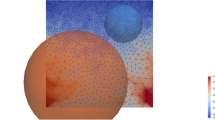Abstract
This paper presents an interactive hybrid topology optimization method that (1) employs density for topology optimization and (2) in a seamless fashion uses a Deformable Simplicial Complex for shape optimization. Omitting hole insertions during the shape optimization allows us to utilize adaptive mesh coarsening, which reduces the mesh size with up to seven times. The result is a combined method which can reduce computation time up to ten times in comparison with pure Lagrangian methods, while still producing adaptive meshes of good quality for analysis and design. Given the robustness of the method, we are able to perform topology optimization by explicit meshing and shape optimization on a mobile device at frame rates that allow for real-time user interaction. The resulting “TopOpt Shape” app is available in the App Store for iOS devices.














Similar content being viewed by others
References
Aage N, Nobel-Jørgensen M, Andreasen CS, Sigmund O (2013) Interactive topology optimization on hand-held devices. Struct Multidiscip Optim 47:1–6
Allaire G, Dapogny C, Frey P (2011) Topology and geometry optimization of elastic structures by exact deformation of simplicial mesh. Comptes Rendus Mathematique 349(17-18):999– 1003
Allaire G, Jouve F, Toader AM (2004) Structural optimization using sensitivity analysis and a level-set method. J Compute Phys 194(1):363–393
Bærentzen JA Deformable Simplicial Complex. https://github.com/janba/2D-DSC
Bendsoe MP (1989) Optimal shape design as a material distribution problem. Structural Optimization 1:193–202
Bletzinger KU, Maute K (1997) Towards generalized shape and topology optimization. Eng Optim 29(1-4):201–216
Chen Y, Davis TA, Hager WW, Rajamanickam S (2008) Algorithm 887: CHOLMOD, supernodal sparse Cholesky factorization and update/downdate. ACM Trans Math Softw 35(3):1–14
Chen Y, Davis TA, Hager WW, Rajamanickam S (2008) Algorithm 887: CHOLMOD, supernodal sparse Cholesky factorization and update/downdate. ACM Transactions on Mathematical Software (TOMS) 35(3):22
Christiansen AN, Bærentzen JA, Nobel-Jørgensen M, Aage N, Sigmund O (2015) Combined shape and topology optimization of 3D structures. Computers & Graphics 46:25–35
Christiansen AN, Nobel-jørgensen M, Aage N, Sigmund O, Bæ rentzen JA (2013) Topology optimization using an explicit interface representation. Structural and Multidisciplinary Optimization 49(3):387–399
Da F, Batty C, Grinspun E (2014) Multimaterial mesh-based surface tracking. ACM Trans Graph 33(4):1–11
Davis TA (2015) Suite sparse. http://faculty.cse.tamu.edu/davis/suitesparse.html
Eschenauer HA, Kobelev VV, Schumacher A (1994) Bubble method for topology and shape optimization of structures. Structural Optimization 8(1):42–51
Ha SH, Cho S (2008) Level set based topological shape optimization of geometrically nonlinear structures using unstructured mesh. Comput Struct 86(13-14):1447–1455
Kim DH, Lee SB, Kwank BM, Kim HG, Lowther DA (2008) Smooth boundary topology optimization for electrostatic problems through the combination of shape and topological design sensitivities. IEEE Trans Magn 44(6):1002–1005
Lian H, Christiansen AN, Tortorelli DA, Sigmund O, Aage N (2017) Combined shape and topology optimization for minimization of maximal von Mises stress. Struct Multidiscip Optim 55(5):1541–1557
Misztal MK, Bærentzen JA (2012) Topology-adaptive interface tracking using the deformable simplicial complex. ACM Trans Graph 31(3):1–12
Nambiar RV, Valera RS, Lawrence KL, Morgan RB, Amil D (1993) An algorithm for adaptive refinement of triangular element meshes. Int J Numer Methods Eng 36(3):499–509
Nguyen TT, Dahl VA, Bærentzen JA, Trinderup CH (2018) Multi-phase volume segmentation with tetrahedral mesh. In: BMVC, pp 2–3
Osher S, Fedkiw R (2006) Level set methods and dynamic implicit surfaces. vol 153 Springer Science & Business Media
Sigmund O (2003) Topology optimization—theory, methods and applications
Svanberg K (1987) The method of moving asymptotes—a new method for structural optimization. Int J Numer Methods Eng 24(2):359–373
Tcherniak D, Sigmund O (2001) A web-based topology optimization program. Struct Multidiscip Optim 22:179–187
Wang MY, Wang X, Guo D (2003) A level set method for structural topology optimization. Comput Methods Appl Mech Eng 192(1-2):227–246
Wojtan C, Thürey N, Gross M, Turk G (2009) Deforming meshes that split and merge. ACM Trans Graph 28(3):1
Xia Q, Shi T, Liu S, Wang MY (2012) A level set solution to the stress-based structural shape and topology optimization. Comput Struct 90-91(1):55–64
Yamasaki S, Nomura T, Kawamoto A, Sato K, Nishiwaki S (2011) A level set-based topology optimization method targeting metallic waveguide design problems. Int J Numer Methods Eng 87 (9):844–868
Funding
This work received financial support from the Villum Foundation (through the VILLUM investigator project InnoTop).
Author information
Authors and Affiliations
Corresponding author
Ethics declarations
Conflict of interest
The authors declare that they have no conflict of interest.
Additional information
Responsible Editor: Julián Andrés Norato
Replication of results
Section 6 introduces the TopOpt Shape app that uses the proposed method for structural optimization.
Publisher’s note
Springer Nature remains neutral with regard to jurisdictional claims in published maps and institutional affiliations.
Rights and permissions
About this article
Cite this article
Nguyen, T.T., Bærentzen, J.A., Sigmund, O. et al. Efficient hybrid topology and shape optimization combining implicit and explicit design representations. Struct Multidisc Optim 62, 1061–1069 (2020). https://doi.org/10.1007/s00158-020-02658-5
Received:
Revised:
Accepted:
Published:
Issue Date:
DOI: https://doi.org/10.1007/s00158-020-02658-5




